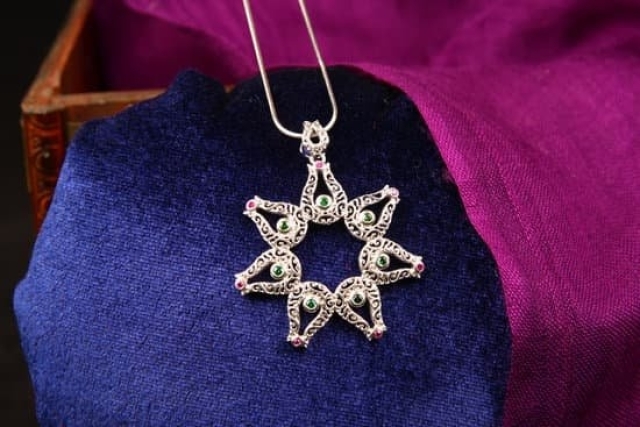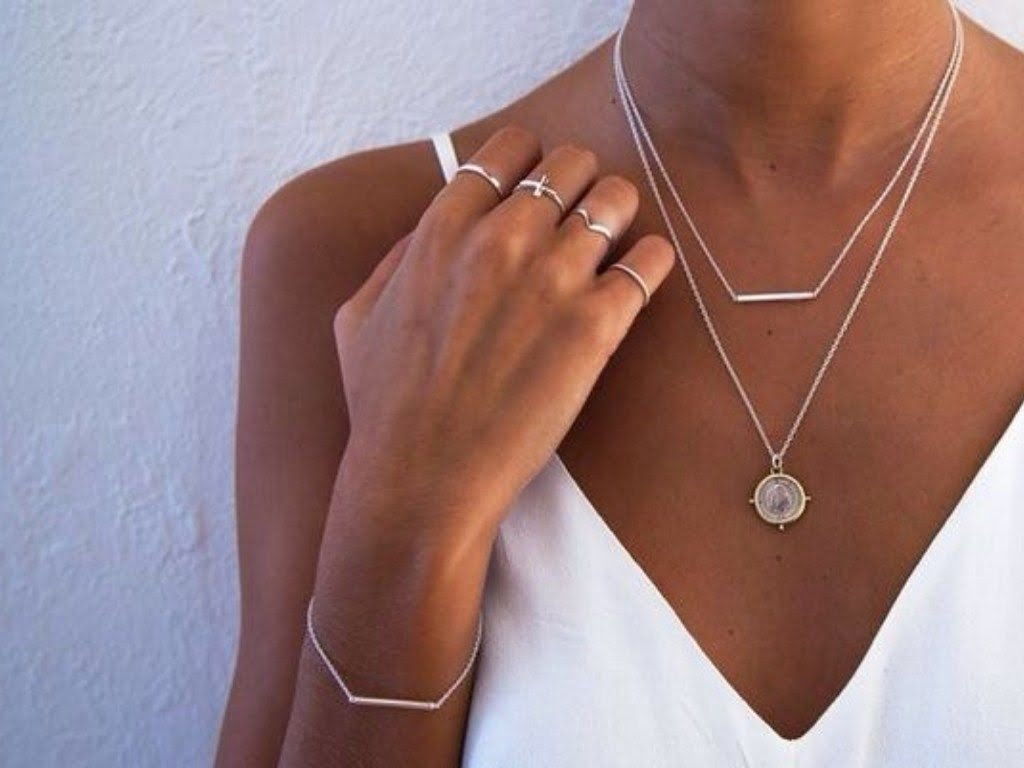The mystery of jewelry turning skin green has baffled people for a long time. Have you ever taken off your jewelry only to discover that it left a strange tint on your skin? Chances are, it’s due to the type of metal inside the ring or necklace. Some metals can cause this reaction when they come into contact with oils and acids in the skin and have an oxidizing reaction as well as another oxidation process called galvanic corrosion.
Chemical Reaction
An example of this would be copper, which tends to turn finger green because of the acidic elements in sweat. An oxidation process occurs when the copper combines with acid. This produces a chemical compound called Copper Chloride, which is blue-green in color and reacts with proteins in the skin to give it a distinctive tint. Silver can also cause this reaction; however, due to its more ‘resistant’ surface, it takes longer for silver to oxidize than copper does.
Galvanic Corrosion
Another reason why jewelry may turn some people’s skin green is due to “galvanic corrosion”. If a piece is made out of two different metals – such as gold plated silver – then the two metals could react differently when exposed to moisture from sweat or water, producing an electrical current which can speed up oxidation. This leads to a tarnishing effect on one metal and an even green tint on the wearer’s skin.
Other Metals
Alongside copper and silver, alloyed materials like brass and bronze – which are composed of both copper and zinc – can also irritate sensitive skins and turn them green over time because they contain molecules that are able to bond with moisture molecules (aka sweat) on your skin’s surface creating an unpleasant coating on the area.
It’s important however, that if you do experience any reactions after wearing certain pieces of jewelry consult with a doctor or dermatologist before continuing wearing them if irritation persists.
What Causes Jewelry to Discolor Skin?
There are many different materials present in jewelry today, and these can cause discoloration of the skin if care isn’t taken in choosing the best materials for each jewelry piece. One example is nickel, which is a white metal used frequently in inexpensive manufactured jewelry; nickel that exists in a small enough concentration often causes greenish or blackish discoloration of the area that is in contact with it.
Copper is another material found commonly in jewelry and is usually layered with a harder metal such as stainless steel or silver to make a stronger piece. However, copper can react with oxygen and sweat on skin surfaces over time to produce chemical compounds known as cupric oxide, which turn skin areas green when exposed to moisture.
The most common type of jewelry-related discoloration is caused by reactions between bronze, brass and zinc metals that contain an alloy material called cadmium. This type of reaction causes a yellow-green blotchy appearance on the parts of skin that have been exposed to these elements for any length of time.
Colorful beads made from stain-resistant dyes can also add to this affect as well as causing inflammation due to their relatively low pH levels compared to other types of beads. And finally, recent studies have shown that sterling silver containing impurities such as lead can cause dark patches on skin after prolonged exposure; although this particular problem largely disappears when pure silver is used instead.
In addition to cause skin discolorations, cheaply manufactured jewelry will sometimes contain bacteria and allergens that were not completely removed during the manufacturing process. Allergic reactions induced by wearing this type of tainted jewelry will often cause additional rashes and itching along with further discolorations; sometimes these signs can even point towards more severe health risks so it’s important take care to only purchased tested metals whenever possible.
With these potential risks aside however, using proper precautions when wearing certain metals will minimize both tarnishing and potential damage to your tender skin areas while ensuring that your favorite pieces remain free from green or black patches caused by toxic reaction build up.
How Does Jewelry Turn Skin Green?
Jewelry that turns skin green is made of certain metals which have a high copper content. The copper reacts with sweat, skin oils and lotions in order to oxidize. This reaction causes the jewelry to change color. Common metals such as brass, nickel, bronze and copper will often cause this discoloration on your skin.
What many people don’t realize is that the metal itself isn’t actually turning your skin green – rather, it’s leaving a harmless residue on your skin that has taken on an emerald hue. The amount of protection given by the thin layer of tarnish is equal to none, so it’s important to take steps to reduce the chances of having green jewelry stained around your fingers and wrists.
To prevent jewelry from turning your skin green there are a few steps you can take. Firstly, make sure that all jewelry pieces are correctly sealed with a protective coating such as gold-plated or rhodium plating which will help stop the amount of tarnishing on both skin and jewellery.
Secondly, ensure you properly care for and store all jewelry pieces regardless of their metal type; keep them away from water and excessive amounts of heat or light which could accelerate oxidation processes.
Additionally, keep lotions or perfumes away from jewelry when wearing it as they can further contribute to oxidation reactions turning your beautiful jewelry into unwanted dark shades ranging from blues through greens to even darker hues over time. Finally, remember to take off all jewelry before swimming or exercising as this can intensify skin discoloration caused by sweating in combination with specific metals present in your pieces.
Common Metals That Can Discolor Skin
Jewelry is a popular fashion accessory, but sometimes wearing it can leave behind an unintended effect: turning your skin green. This discoloration is caused by metal reacting with body chemicals to form deposits on the skin.
There are many different types of metal and materials used to create jewelry, all of which have different reactions when exposed to sweat, oils, and other substances in the body. Knowing common metals that can discolor skin will help you identify which type of jewelry might cause this unsightly reaction.
Sterling silver is a popular choice for jewelry due to its bright luster and durability, but it’s also one of the most likely metals to turn the skin green. This is because sterling silver jewelry usually contains copper; when exposed to air and moisture, the copper reacts with sulfur particles in sweat or dirt to form a green patina on the skin. Unfortunately, sterling silver isn’t the only culprit.
White gold (an alloy containing nickel) can cause irritation that turns into rashes or causes discoloration if it comes into contact with your skin often enough. To keep your skin safe from white gold jewelry, choose 18K or higher gold content or get items coated with palladium instead of nickel; both are less likely to cause this discoloration issue.
Costume jewelry is especially prone to causing green discoloring under certain conditions; almost all costume jewelry contains some base metal like brass or copper in order to be more affordable than real gold or silver options without sacrificing too much durability.
Unfortunately, these metals can react quickly with sweat and/or dirt in order to stain your body’s pH levels and turn your skin green over time – especially when worn frequently throughout summer months due to elevated levels of perspiration.
To prevent any unwanted reactions, try buying real gold and silver instead; although more expensive than costume jewelry , they require less maintenance overall since their chemical composition does not easily react with body moisture or oils as easily as base metals do.
It’s important for everyone who wears jewelry regularly knows what kinds of materials can cause their skin discoloration so that they know how best take care of their pieces and avoid unnecessary reactions or stains.
Non-Metals That May Cause Skin Discoloration
One kind of material than can cause skin discoloration, particularly when it comes to jewelry, is non-metals. Non-metal jewelry typically has a base metal that is overlaid with a different coating which gives it its color and additional strength. These coatings can be made from various metals, but some may contain elements that can react to sweat and the oils on your skin and slowly leach out over time causing the skin around them to turn green.
The most typical example of this happening is copper turning your skin green when exposed to air or water; however, other non-metallic alloys such as brass or bronze may also cause a reaction when in contact with skin. Unfortunately, these reactions are impossible to predict in advance as they depend heavily on individual chemistry and even slight variations in the composition of the alloy used during manufacturing might produce vastly different results.
Common metals that are found in alloys used for jewelry production, such as copper and brass, all contain trace amounts of nickel which often serves to strengthen them; however, nickel can also be what causes the reaction resulting in discolored skin if you are allergic or sensitive to it.
Some alloys found in jewelry also contains sulfur-bearing compounds, which have been known to leave an unpleasant residue on your skin after prolonged wearing that would also potentially cause discoloration needing specialty cleaning involving oxalic acid solutions.
Finally, some synthetic materials like plastic resin beads may contain chemical additives that release small amounts of dye into your skin upon contact if not properly tested for safety standards prior to use. They will usually not turn your skin “green” per say but instead could give your jewelry piece a deep blue hue from dye leaching out onto yourskin overtime without proper protection between it and yourself while wearing it.
To prevent this from happening make sure you look into what type of materials were used before purchasing any type of jewelry or accessories as knowledge is power.
Ways to Prevent Discoloration from Jewelry
Jewelry made from cheap, low-quality metals such as copper or brass is often the culprit behind skin discoloration. When these metals come into contact with sweat or other moisture, a chemical reaction between the metal and your bodily fluids can cause the metal to leave a green residue on your skin.
Unfortunately, this discoloration usually lasts for several hours and can be difficult to disguise while wearing jewelry. Luckily, there are ways to prevent this unsightly blotch from appearing on your skin when wearing jewelry.
The first way to prevent discoloration comes down to making an informed decision before you buy any type of jewelry. Stick to pieces made with higher grade metals like stainless steel, sterling silver, titanium or gold which react much better against exposure to bodily fluids. These types of metals should not cause you any problems when worn in high concentrations of sweat such as during physical activities outdoors or in gyms.
Additionally, you can prolong the lifespan of your jewelry by regularly cleaning and polishing them with materials especially designed for that purpose. A good quality cleaner removes residue buildup that builds up over time under the unexpected exposure from sweat and oil which can also contribute to discoloration if allowed to accumulate over time.
Furthermore, keep your silver jewelry in anti-tarnish bags which help reduce tarnishing while protecting it from scratches it could acquire when it rubs against other pieces of jewelry inside a bag or drawer where they are stored for periods of non-use.
Lastly, a protective coating could be added onto cheap material based jewelry by having it dipped into a hypoallergenic clear lacquer sealant bath that works like an extra layer of protection for delicate pieces prone to discoloration under extreme conditions such as overexposure from sweat or daily wear.
It forms an invisible barrier between the metal and the air preserving its original color without compromising its durability which makes it ideal for those individuals who suffer from easily triggered allergies to new material types in their body piercing accessories and jewelry alike.
Natural and Safe Solutions to Wearing Jewelry
Jewelry is a great way to add an extra bit of flair and style to any outfit. However, sometimes when you wear jewelry, your skin may discolor into a strange green hue.
This usually happens with cheap metal jewelry, which contains copper or zinc alloys that contain much lower levels of purity than jewelry made from silver, gold, platinum, or palladium. Copper reacts with sweat and oils on the skin to form an oxidized compound that has a green tint to it.
Fortunately there’s no need to give up wearing jewelry just because you have sensitive skin. You can still enjoy all the benefits of wearing jewelry without experiencing any adverse reactions by looking out for certain materials that are less likely to cause discoloration.
High-quality silver jewelry is generally safe for most people as it is made from sterling silver which contains 92.5% pure silver and 7.5% pure copper-a much lower amount than in copper alloys used in costume jewelry that are more likely to cause discoloration. Gold and platinum are also relatively safe metals for those with sensitive skin since they don’t react with sweat or oil as readily as copper does.
To ensure that you don’t experience any discoloration when wearing your favorite pieces of jewelry, be sure to always keep it clean and free from dirt or sweat buildup-which can worsen the risk of oxidation reactions on the skin.
If you do notice any discoloration occurring on your skin after wearing a piece of jewelry, try switching it out for something made from different materials such as gold, silver or platinum instead of lower-grade metals like zinc or brass that are more prone to causing these reactions.
Additionally, make sure you’re taking proper care of your pieces by regularly cleaning them so they don’t collect dirt or oils which could lead to further discoloration when worn against your skin too often.
How to Treat Jewelry that has Discolored Skin
Materials used in jewelry can contain certain levels of copper, zinc and brass which can cause human skin to discolor or turn green. This is generally caused by the oxidation of the metal. A reaction occurs once the metal comes into contact with acids found on skin and hair, as well ashumidity and sweat.
The resulting chemical reaction creates a dark-green discoloration known as verdigris. This will happen most often with items such as earrings, bracelets or rings that are made from unique combinations of alloy materials containing copper, especially those that are coated in a plating such as gold.
To avoid this from happening or to remove existing discoloration it is important to clean your jewelry regularly to prevent oils and other substances from building up on the surface of the metal. Cleaning can be done easily by using either warm soapy water or an off-the-shelf jewelry cleaner available at retail stores.
To be sure all residue, oils and chemicals are removed you may need to use a soft bristled brush along with some light scrubbing motion while doing this process. Be sure not to damage any delicate stones, pearls or filigree work that may have been included in with the piece of jewelry though, because excessive cleaning can affect them negatively.
If you have already noticed greenish discoloration on your skin where the jewelry was worn then you’ll want to take action immediately to stop the discoloring from worsening. The first step is taking off any jewelry immediately after it has been worn which allows it dry completely before storing it away from humidity and direct sunlight since these can also accelerate oxidization reactions if left for extended periods of time in them.
If possible try wearing costume based jewelry that does not contain an alloy since those made without metals are less likely to cause greenish staining due to body contaminants unlike their counterparts consisting of metal alloys used for fine quality pieces.
Conclusion
Antique and costume jewelry that contain a high amount of copper or silver are the most likely culprits when it comes to making skin turn green. Copper has a tendency to react with human sweat and skin, creating our signature greenish tinge.
Additionally, metals like bronze and brass have also been known to create similar reactions with human skin. The element nickel is often found in certain kinds of jewelry, including watches and earrings, but is an unlikely cause for this skin discoloration since it is largely considered hypoallergenic and doesn’t normally provoke reactions from skin contact.
Given that this pyrite-induced phenomenon can occur easily when wearing certain kinds of jewelry, it’s important to take several precautions in order to mitigate the undesired effects. One option is to limit the amount of time you spend wearing your jewelry.
If you’re going out for the evening or attending an event, consider removing any jewellery during that time frame so that your body doesn’t come into direct contact with the metals contained in them. Additionally, making sure these pieces don’t come into contact with creams or lotions could be beneficial when trying to avoid getting any green stains on your body.
Moreover, if you happen to own antique silver or copper-based jewelry pieces that may tend to cause discolorations around your fingers or wrists, then cleaning them regularly might be useful in preventing this reaction. Specialized polishing cloths or even baking soda can make it easier to rid these pieces of unwanted dirt and residue; this way, oxidation won’t occur as quickly upon direct contact with human sweat and skin.
Last but not least: always do a patch test before purchasing new items/ buying more clothing or accessories as certain materials might irritate your individual’s own skin care regimen.

Welcome to my jewelry blog! My name is Sarah and I am the owner of this blog.
I love making jewelry and sharing my creations with others.
So whether you’re someone who loves wearing jewelry yourself or simply enjoys learning about it, be sure to check out my blog for insightful posts on everything related to this exciting topic!





